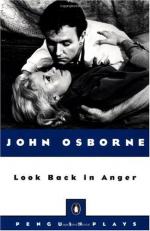|
This section contains 282 words (approx. 1 page at 400 words per page) |

|
Look Back in Anger Summary & Study Guide Description
Look Back in Anger Summary & Study Guide includes comprehensive information and analysis to help you understand the book. This study guide contains the following sections:
This detailed literature summary also contains Bibliography and a Free Quiz on Look Back in Anger by John Osborne.
On May 8, 1956, Look Back in Anger opened at the Royal Court Theatre as the third production of the newly formed English Stage Company. The English Stage Company had been founded in 1955 to promote the production of new plays by contemporary authors that might not find production in the commercial West End theatre (London's equivalent of Broadway in New York City). West End theatre provided quality acting and high standards of production, but very little drama that related to life m contemporary England. Most plays of the time were generally innocuous light comedies, thrillers, and foreign importsfourteen American shows in 1955 alone. Osborne had submitted copies of Look Back in Anger to every agent in London and to many West End producers and had been rejected by all. When the script arrived at the Royal Court, the Artistic Director George Devine and his young assistant director Tony Richardson knew it was exactly what they were looking for. Look Back in Anger was viewed as a play that would, as Devine later put it, "blow a hole in the old theatre."
Critical reception was strongly mixed: some detested the play and the central character, but most recognized Osborne as an important new talent and the play as emotionally powerful. They also recognized the play as one that fervently spoke of the concerns of the young in post-war England. Although the first production of Look Back in Anger was not initially financially successful, after an excerpt was shown on BBC the box office was overwhelmed. Osbome was publicized as the "Angry Young Man" and the success of Look Back in Anger opened the doors to other young writers who dealt with contemporary problems.
Read more from the Study Guide
|
This section contains 282 words (approx. 1 page at 400 words per page) |

|



